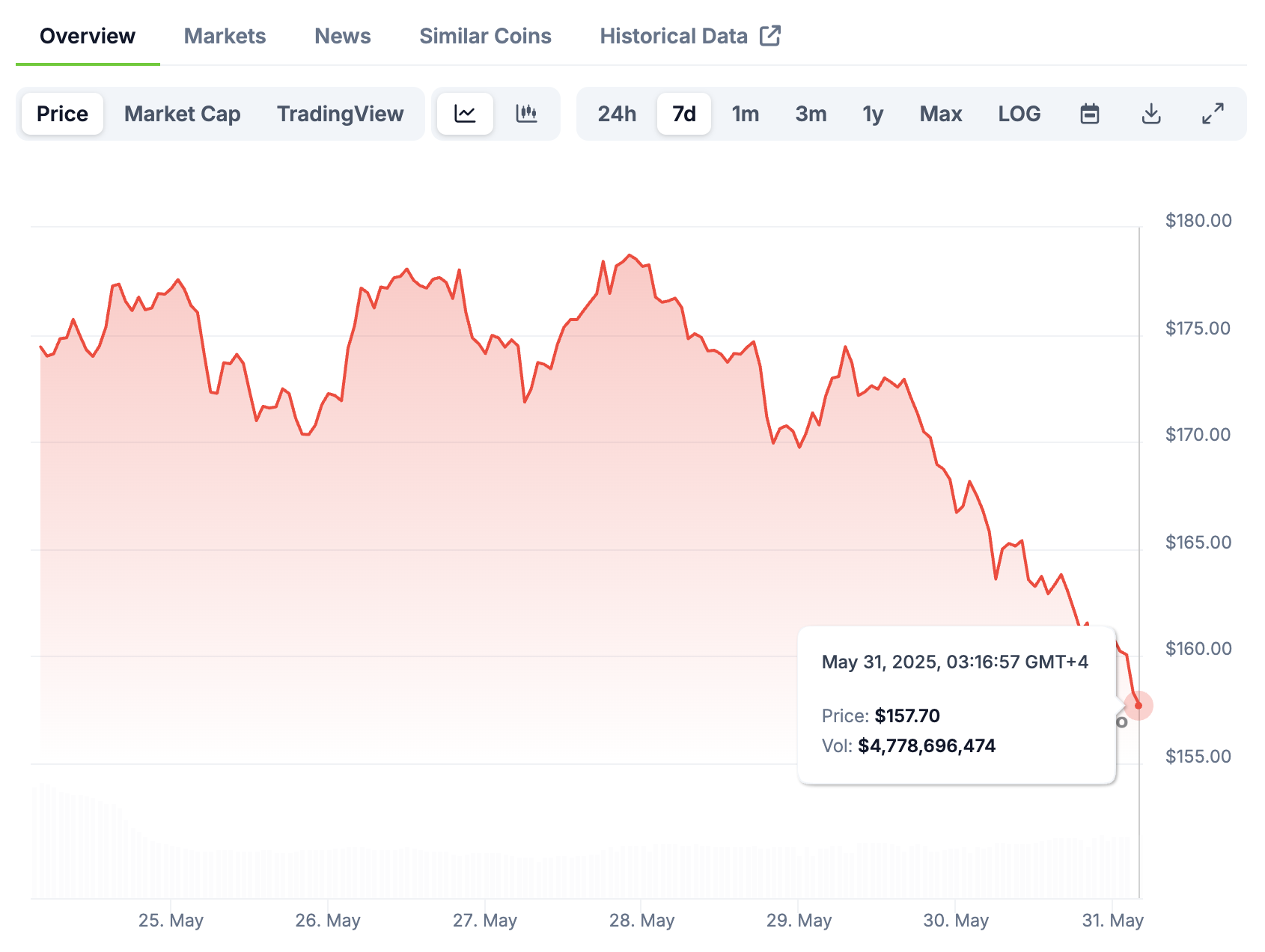Trump's remarks on tariffs sent the crypto market down yesterday
Original | Odaily Planet Daily (@OdailyChina)
Author|jk

May 30, the overall crypto market fell below $104,000 as Trump claimed that there might be a new round of tariff measures , the mainstream currencies generally fell. Investor sentiment tends to be cautious, and the market lacks a clear upside catalyst in the near term.
According to Coingecko data, BTC was quoted at $104, 028, down 1.7% in the past 24 hours, and the 7-day decline extended to 3.8%, and the market capitalisation fell back to $2.07 trillion. Although volume remained high at $39.3 billion, price action remained under pressure. ETH fell even more significantly, falling 4% in 24 hours and is currently trading at $2,520, dropping its market cap to $306.8 billion.
 --
--
>Solana's declines have been concentrated in the past 2 days, source: Coingecko
SOL has become the mainstream asset with the largest pullback, down 5.4% in 24 hours and as much as 10.7% for the week, and is now trading at $157, falling below the $160 mark. BNB was relatively resilient, but also recorded an intraday decline of 2.5% and is now trading at $662. XRP was at $2.16, down 4.7% in 24 hours and down 7.3% for the week.
Dogecoin (DOGE) emerged as one of the weakest coins in this round of pullback, down 9.8% on the day and 15.1% for the week, and is now trading at $0.1961. Although the community is still hot, there are clear signs of outflows. In the absence of major positive or fundamental support, the crypto market is facing certain repair pressure in the short term. At present, funds tend to be risk-averse, and more flows to stablecoins or temporarily leave the market.
Reason analysis: Tariff policy volatility triggers risk aversion, the market is under short-term pressure
, and the Trump administration has taken many measures on tariffs recently, and here is a summary version according to the timeline:
May 29:
TheU.S. Court of International Trade ruled that most of the Trump administration's global tariff policies were illegal, finding that the International Emergency Economic Powers Act (IEEPA), which it invokes, does not authorise the president to impose tariffs on almost all imports. The Court stressed that, under the Constitution, trade policy should be led by Congress and not unilaterally decided by the President. The White House immediately appealed, accusing judicial interference of hampering its economic diplomacy strategy, and trade policy uncertainty rose significantly.
May 30:
A federal appeals court urgently rules to suspend the lower court's ruling, allowing the Trump administration to continue imposing tariffs while the lawsuit continues. This reversal has exacerbated concerns about policy reversal and enforcement, with outflows leading to a shift towards stablecoins and USD assets. A White House spokesman publicly said that court intervention was undermining U.S. bargaining chips in trade negotiations and criticised judges for "overstepping their authority."
Subsequently, the immediate cause of this market decline was another post on Truth Social, in which Trump accused China of "serious violations" of the mutual tariff exemption agreement reached in Geneva in the middle of this month. He said he had briefly conceded to "suspend punitive tariffs of up to 145 percent" to avoid a deterioration of the situation in China, but would consider renewing the pressure. The statement once again sent a signal of trade tension, and the market is worried about the new round of conflict between China and the United States. Against the backdrop of rising risk aversion, the crypto market has become one of the main directions of capital retracement, and mainstream currencies have generally fallen during the day.
Trump's negotiating style? Or is a tariff war really coming?
Trump's negotiation style has always been characterised by "maximum pressure" and "tactical back-and-forth", that is, through high-profile threats and uncertainty, to gain a negotiating advantage. This tactic is common in its trade negotiations with China and Europe.
Previously, a similar strategy was seen in the US-EU trade relationship. After most of the tariffs had settled, Trump had threatened to impose 50% tariffs on EU goods from June 1, and then postponed the implementation date to July 9 after a phone call with European Commission President Ursula von der Leyen. The EU welcomes this and expresses its willingness to expedite the negotiation process.
This cycle of "high-pressure-de-escalation-re-pressure" has given the market the impression that Trump is always timid (TACO) in his negotiating strategy, that is, he tends to back down after exerting pressure. Although Trump strongly disagreed, saying that his strategy was to gain a greater advantage in the negotiations, the market remained sceptical.
Given past experience, despite the current resurgence of US-China trade tensions, it is widely expected that the two sides may eventually negotiate a new agreement to avoid further escalation. As a result, the market may experience volatility in the short term, but in the long term, no serious trade conflicts are expected.
